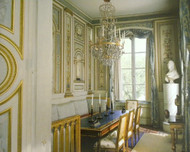Versailles to Stockholm a Journey Through Antique Furniture Styles
Nov 15th 2023
There's a certain allure that surrounds antique furniture. With every contour and imperfection, they recount stories of epochs long past and of artistry that evolves. As we traverse history and design, two countries stand tall with their distinctive contributions to the world of furniture: France and Sweden.
In this exploration, we look into the heritage and distinctions of French and Swedish antique furniture, unveiling the subtleties that set them apart and the historical currents that have shaped them.

Image of Haga Palace in Sweden from Petite Haus
A Glimpse into French Furniture's Golden Era
The French, known for their romantic sensibilities and opulence, have left an indelible mark on the world of interior design. The foundations of French furniture design can be traced back to the Renaissance period, where intricate carvings, flamboyant motifs, and a generous use of gilding encapsulated the era's spirit. As the centuries progressed, so did the influences on French furniture.
The reigns of Louis XIV, XV, and XVI each brought distinct styles. Louis XIV's Sun King reign ushered in the Baroque style: grand, dramatic, and overflowing with gold. Then came the Rococo of Louis XV, characterized by lighter colors, delicate curves, and ornate details. Louis XVI’s period introduced Neoclassical elements as designs became more structured, drawing inspiration from Greek and Roman antiquities.
Regardless of the period, French furniture always maintained an air of sophistication. Their pieces showcased exemplary craftsmanship with a penchant for luxury, using the finest materials like mahogany, walnut, and ormolu mounts. Every piece, be it an armoire or a chaise longue, held a mirror to the country’s artistic zeitgeist, reflecting the social, political, and artistic evolutions of the times.
Swedish Simplicity and Functionality
On the other end of the design spectrum, Swedish antique furniture sings a different, albeit equally captivating, tune. Born out of practicality due to Sweden's harsh climate and a predilection for functionality, Swedish designs embraced minimalism long before it became a global trend.
The 18th-century Gustavian style, named after King Gustav III, is a hallmark of Swedish furniture design. Drawing inspiration from his visits to the French court, King Gustav introduced neo-classical designs with a distinct Swedish twist. French furniture's heavy ornamentation and rich colors were replaced with muted tones, straight lines, and reserved detailing, aptly reflecting the Swedish love for simplicity and functionality.
Swedish furniture often utilized native woods like pine and was painted to brighten interiors during the long, dark winters. The pale blues, grays, and whites that came to characterize Swedish pieces weren't just aesthetic choices but were strategic in bringing light into homes. Functionality was the focus, but that didn't preclude elegance. Swedish furniture's slender silhouettes and understated charm, from Mora clocks to iconic chairs, epitomized a fusion of form and function.
Contrasts and Commonalities
While French and Swedish furniture designs diverged in many ways, rooted in their unique histories and societal contexts, they also bore certain similarities. Both styles underwent transformations influenced by the reigning monarchs of their times. They both absorbed and reflected their eras' broader cultural and artistic movements, from Renaissance revivalism to Neoclassicism.
Yet, their approach to design and aesthetics is the most stark contrast. French furniture, with its grandeur and penchant for the ornate, tells tales of a nation that adored opulence. In contrast, with its restraint and functional elegance, Swedish furniture speaks of a culture grounded in simplicity and practicality.
Modern-Day Inspirations
Today, both French and Swedish antique furniture styles are revered artifacts and sources of inspiration for contemporary designs. Their influence can be seen in the antique reproduction furniture that seeks to blend the historical charm of the past with the needs of the modern world.
For those who wish to imbue their homes with a touch of the past, embracing French furniture's intricate artistry or the minimalist elegance of Swedish designs can transform living spaces. As they say, in furniture, as in life, the harmonious blend of contrasts makes things truly interesting.
À la Prochaine Histoire
French and Swedish antique furniture offers a journey through time, echoing the sentiments and artistry of their respective periods. As we come to the end of this exploration, we are reminded that every piece of furniture, be it from France or Sweden, is not just a functional object but a testament to human creativity and history. Until our next tale, may your home always resonate with stories as timeless as the furniture that adorns it.
À bientôt, et que votre maison soit toujours remplie d'histoires intemporelles.


